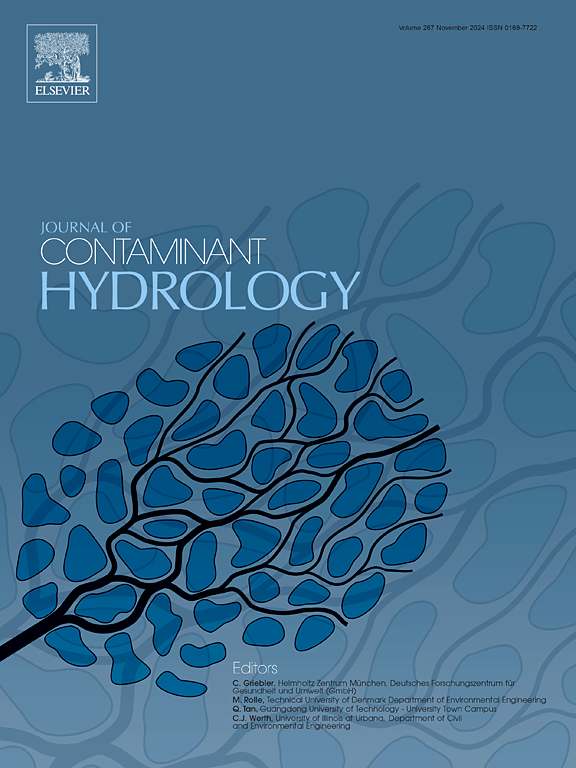Field application of bioelectrochemical reduction technology for treating hexavalent chromium in groundwater
IF 4.4
3区 环境科学与生态学
Q2 ENVIRONMENTAL SCIENCES
引用次数: 0
Abstract
Hexavalent chromium [Cr(VI)] is one of the most prevalent contaminants in groundwater. Contemporary in situ remediation approaches, such as chemical reduction, chemical immobilization, and biological reduction, have been widely implemented at various contaminated sites. However, these “contact-based” technologies tend to be restricted by matrix of tight lithology such as clay and fractured bedrocks. Electrochemical techniques can overcome such impedes due to its working mechanism based on electron transport. In this pilot study, a commercialized bioelectrochemical reduction (BECR) technology (trademarked as E-Redox®-R by Advanced Environmental Technologies, LLC, Colorado, USA) was applied at a Cr(VI)-contaminated site in Henan Province, China, to remediate chromium contamination in groundwater. This project represents the first field application of the BECR technology in Mainland China for Cr(VI) treatment. The BECR pilot system consisted of four units, comprising 12 electrodes installed across a 38.5-m transect. For each unit, one anode well and two cathode wells were arranged in an isosceles triangle configuration, with an inter-electrode spacing of 5.5 m. Within 10 months of system operation, groundwater Cr(VI) concentrations in the cathode wells ranging from 0.3 mg/L to 46.5 mg/L decreased by 24 % to 99 % despite potential masking effects by the desorption of chromium mass from the soil matrix into the aqueous phase. Within the treatment zone, Cr(VI) concentrations in the two upgradient monitoring wells located near the anode electrodes decreased by 21 % and 42 %, respectively, while concentrations in the three downgradient monitoring-compliance wells near the cathode electrodes decreased by 65 % to 96 %. These results indicate that the BECR technology can effectively reduce Cr(VI) in the subsurface and holds promise as a sustainable in situ technology for remediating chromium and other contaminants impacted groundwater.
生物电化学还原技术处理地下水中六价铬的现场应用
六价铬[Cr(VI)]是地下水中最常见的污染物之一。当代的原位修复方法,如化学还原、化学固定化和生物还原,已广泛应用于各种污染场地。然而,这些“基于接触”的技术往往受到黏土和裂缝性基岩等致密岩性基质的限制。电化学技术基于电子传递的工作机制可以克服这些障碍。在这项试点研究中,一种商业化的生物电化学还原(BECR)技术(注册商标为E-Redox®-R,由Advanced Environmental Technologies, LLC, Colorado, USA)应用于中国河南省一个Cr(VI)污染的场地,以修复地下水中的铬污染。本项目是BECR技术在中国大陆首次应用于Cr(VI)处理。BECR试验系统由四个单元组成,包括12个电极,安装在38.5米的样带上。每个单元的一个阳极井和两个阴极井呈等腰三角形布置,电极间距为5.5 m。在系统运行的10个月内,阴极井中地下水铬(VI)浓度从0.3 mg/L到46.5 mg/L下降了24%至99%,尽管铬质量从土壤基质解吸到水相可能产生掩蔽效应。在处理区内,位于阳极电极附近的两个上梯度监测井的Cr(VI)浓度分别下降了21%和42%,而靠近阴极电极的三个下梯度监测井的Cr(VI)浓度下降了65%至96%。这些结果表明,BECR技术可以有效地降低地下水中的Cr(VI),有望成为一种可持续的原位修复地下水中铬和其他污染物的技术。
本文章由计算机程序翻译,如有差异,请以英文原文为准。
求助全文
约1分钟内获得全文
求助全文
来源期刊

Journal of contaminant hydrology
环境科学-地球科学综合
CiteScore
6.80
自引率
2.80%
发文量
129
审稿时长
68 days
期刊介绍:
The Journal of Contaminant Hydrology is an international journal publishing scientific articles pertaining to the contamination of subsurface water resources. Emphasis is placed on investigations of the physical, chemical, and biological processes influencing the behavior and fate of organic and inorganic contaminants in the unsaturated (vadose) and saturated (groundwater) zones, as well as at groundwater-surface water interfaces. The ecological impacts of contaminants transported both from and to aquifers are of interest. Articles on contamination of surface water only, without a link to groundwater, are out of the scope. Broad latitude is allowed in identifying contaminants of interest, and include legacy and emerging pollutants, nutrients, nanoparticles, pathogenic microorganisms (e.g., bacteria, viruses, protozoa), microplastics, and various constituents associated with energy production (e.g., methane, carbon dioxide, hydrogen sulfide).
The journal''s scope embraces a wide range of topics including: experimental investigations of contaminant sorption, diffusion, transformation, volatilization and transport in the surface and subsurface; characterization of soil and aquifer properties only as they influence contaminant behavior; development and testing of mathematical models of contaminant behaviour; innovative techniques for restoration of contaminated sites; development of new tools or techniques for monitoring the extent of soil and groundwater contamination; transformation of contaminants in the hyporheic zone; effects of contaminants traversing the hyporheic zone on surface water and groundwater ecosystems; subsurface carbon sequestration and/or turnover; and migration of fluids associated with energy production into groundwater.
 求助内容:
求助内容: 应助结果提醒方式:
应助结果提醒方式:


